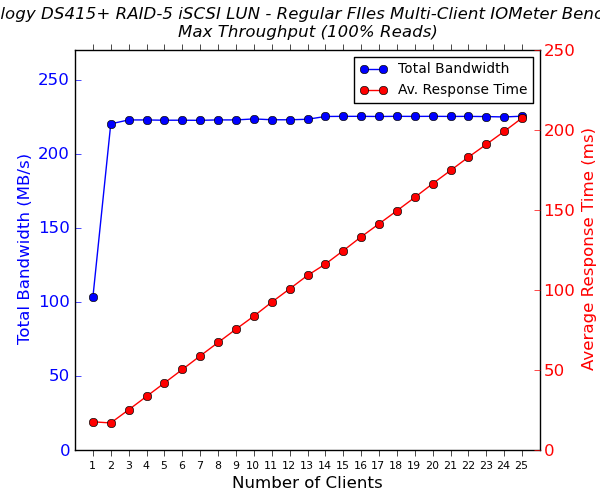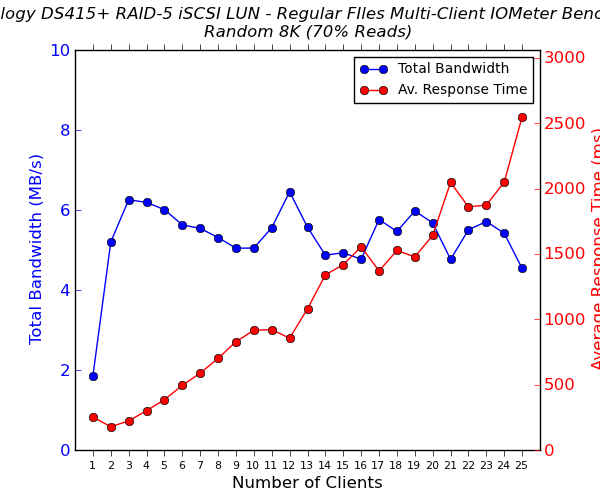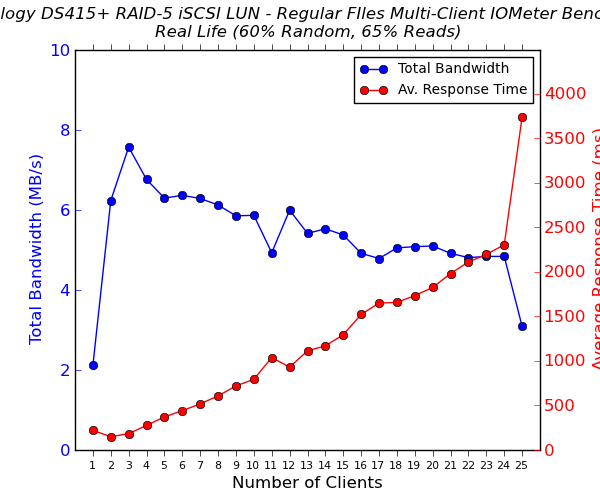Synology DS415+ Review: DSM on Intel Rangeley
by Ganesh T S on October 30, 2014 7:30 AM EST- Posted in
- NAS
- Storage
- Intel
- Synology
- Silvermont
- Enterprise
- Rangeley
Multi-Client iSCSI Evaluation
As virtualization becomes more and more popular even in home / power user settings, the importance of the iSCSI feature set of any COTS NAS can't be overstated. Starting with our ioSafe 1513+ review, we have started devoting a separate section (in the reviews of NAS units targeting SMBs and SMEs) to the evaluation of iSCSI performance. Since we have already looked at the way iSCSI LUNs are implemented in DSM in the ioSafe 1513+ review, it won't be discussed in detail.
We evaluated the performance of the DS415+ with file-based LUNs as well as configuring a RAID-5 disk group with a single LUN. The standard IOMeter benchmarks that we used for multi-client CIFS evaluation were utilized for iSCSI evaluation also. The main difference to note is that the CIFS evaluation was performed on a mounted network share, while the iSCSI evaluation was done on a 'clean physical disk' (from the viewpoint of the virtual machine).
Performance Numbers
The four IOMeter traces were run on the physical disk manifested by mapping the iSCSI target on each VM. The benchmarking started with one VM accessing the NAS. The number of VMs simultaneously playing out the trace was incremented one by one till we had all 25 VMs in the fray. Detailed listings of the IOMeter benchmark numbers (including IOPS and maximum response times) for each configuration are linked below:
- Synology DS415+ - iSCSI LUN (Regular Files) - 4x 4 TB / RAID-5 / 2x 1G
- Synology DS415+ - Single LUN on RAID - 4x 4 TB / RAID-5 / 2x 1G




Since the number of NAS units that we have put through this evaluation is limited, the only real point of comparison is the Seagate NAS Pro 4-bay. The ioSafe 1513+ graphs are also linked above, but it has five drives instead of the four in the DS415+. The only graphs for apples-to-apples comparison are those of the Seagate NAS Pro 4-bay units. We see advantages in terms of average access times for the Synology DS415+. This is only to be expected, given the faster clock for the Rangeley SoC in the DS415+.
As more NAS units are processed, we hope this section will provide readers with a way to quickly get an idea of the competitive performance of a particular NAS unit when it comes to iSCSI support.










41 Comments
View All Comments
Arkive - Thursday, October 30, 2014 - link
Does this (or any NAS that you know of) support simultaneous access from both the USB port as well as over the network? I understand the "only one interface can control the storage at one time" issue, but I'm really hoping someone is working to overcome this, even if it means that one of those interfaces is locked into read-only mode.ganeshts - Thursday, October 30, 2014 - link
The USB ports are host ports, i.e, storage devices or WLAN USB sticks can be connected to it. The USB port can't be used to connect to a PC for using the unit as a DAS (direct-attached storage).rpg1966 - Thursday, October 30, 2014 - link
Seriously, articles with graphs showing two aspects of the same thing (e.g. rebuild times in this case) need to be shown on an X-Y chart, so that the trade-offs are immediately and obviously visible.The same goes for many similar pairs of charts you show in other reviews, e.g. power-vs-noise in GPU or case reviews.
echtogammut - Thursday, October 30, 2014 - link
I almost spat coffee all over my monitor when I saw the tertiary drive in the test rig. That is a very expensive way of eliminating the test rig as a performance bottleneck in the tests.Salipander - Thursday, October 30, 2014 - link
It's about time that transcoding includes h265 support, and be mentioned in reviews. This DS415+ unit may provide this for resolutions up to 1080p. This is for sure not supported by the DS415play, as it won't have the cpu power to do this in sw, but the DS415+ just may do it.I have quite a movie collection and I am halving the needed storage by transcoding the files from h264 to h265, including all the sub 4k files (which is 100% of them ;-) I may be an early h265 adopter, but the cpu intensive transcoding is worth the effort already. The x265 coder is of such a good quality now (since august at least), that I dare to go for it.
It would be nice to have the DS Video capability to transcode h265 to something suited for current tablets and media players!
DanNeely - Thursday, October 30, 2014 - link
Is the ram soldered to the PCB, or in a dimm that could be swapped out for an ECC module?skarnm2 - Thursday, October 30, 2014 - link
I did read elsewhere it was soldered. It is on the larger models it's swap-able.chubbypanda - Thursday, October 30, 2014 - link
Non-ECC and ECC modules aren't interchangeable. Do not attempt!mpbrede - Thursday, October 30, 2014 - link
Define COTS, please? Some form of "... Off The Shelf"ganeshts - Thursday, October 30, 2014 - link
Commercial :)I thought it was pretty common usage, and a cursory search online makes me think I may not have been mistaken: http://en.wikipedia.org/wiki/COTS